 |
|

|
 |
TABLE of CONTENTS
|
Twin Ports Interchange project planning for traffic shift, additional work packages |
By Pippi Mayfield, D1 public engagement and communications director
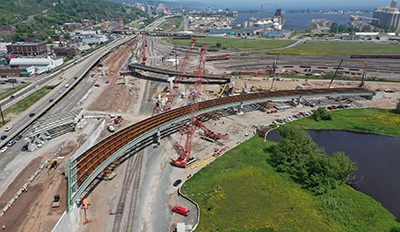
Looking north along I-35, work on the Twin Ports Interchange project includes replacing the northbound lanes of I-35 and the ramps to Wisconsin. Photo by Cheri Gagne
|
Bridges coming down, roadways going up. Anyone who drives I-35 through Duluth this summer is seeing major progress on the Twin Ports Interchange project.
When MnDOT began working on the project, the plan was to include the interchange of I-35, I-535 and Hwy 53 in Duluth (which many people call “the can of worms”), the Hwy 53 bridge through the Lincoln Park neighborhood and the Garfield Avenue/I-535 interchange where the Blatnik Bridge dumps traffic onto city streets.
Once bids came back, the Hwy 53 bridge and Garfield Avenue interchange portions of the project had to be tabled due to a funding gap. The plans were completed to 90%, in hopes that that special funding will be available at some point and finance the projects ahead of their 2027 and 2028 holds in the CHIP. Special funding came this year, and the two work packages are beginning this fall.
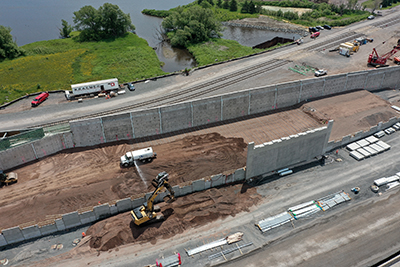
The precast walls along I-35 northbound are being constructed. Traffic will switch to the northbound lanes this fall so that southbound lanes can be torn up and reconstructed. Photo by Cheri Gagne
|
The TPI project began in 2020 with a bridge replacement and was in full swing the following spring, with traffic shifting and the northbound interstate being ripped up. Over the next two years, all ramps to Wisconsin and Hwy 53 were be torn down. A massive box culvert that serves as a carrier for the now combined Miller Creek and Coffee Creek replaced a smaller culvert under the interstate and railroad.
This summer, new ramps are being built and northbound I-35 is being constructed. Much of the interstate that once sat on bridges will now be at the ground level, on elevated roadways. Once the precast walls for that portion of the project have gone up, this area will become the northbound lanes of I-35 and will be open this fall. Traffic currently runs on southbound I-35 and Lower Michigan Street (which was blocked off and used as the southbound I-35 bypass the last year), and will be shifted to the newly constructed northbound I-35 this fall. This will give crews the opportunity to tear down and reconstruct southbound I-35.
“It’s pretty spectacular to see all the simultaneous work happening,” said Pete Marthaler, construction manager, during July’s public update meeting.
Crews have been working year-round on this project, saving about a year of construction time. The project is scheduled to be complete in 2024.
The aeronautics team flies the project each month and sends photos and videos to document progress. They can be seen on the project webpage and D1’s Facebook page.
More information on the project can be found at the TPI webpage.
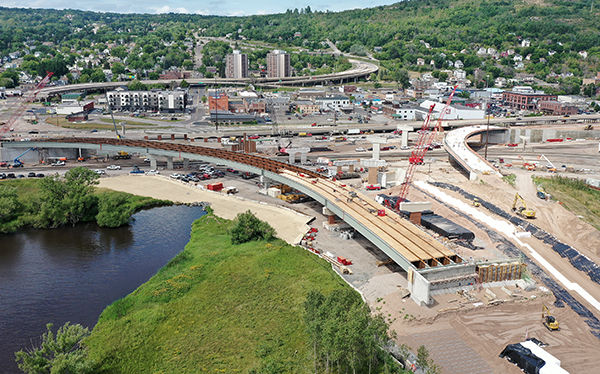
Looking west, the ramps to Wisconsin (foreground) and northbound I-35 are being replaced. Replacement of the Hwy 53 bridge (background) will begin this fall. Photo by Cheri Gagne
|
|
 |
|

|
 |
TABLE of CONTENTS
|
MnROAD summer construction projects help agency plan for the future |
By Lauren Dao, Office of Materials and Road Research
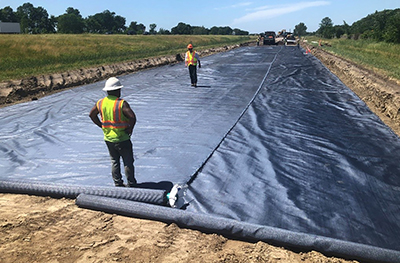
Crews place geotextile fabric prior to asphalt paving to measure its effect on moisture wicking. Photo courtesy of MnROAD
|
Construction season was in full force this year at the MnROAD pavement research facility in Albertville, including demolition and construction at 39 test cells along the I-94 mainline.
The research for these cells is being done primarily through the National Road Research Alliance, for which MnDOT is the administrating state agency; additional funding comes from the MnROAD partnership with the National Center for Asphalt Technologies at Auburn University, Local Road Research Board and other sources. MnDOT also put in $5 million towards the construction costs, and many projects received in-kind gifts in the form of labor, equipment use and products for testing.
Work began in May and started with the removal of more than 800 asphalt cores and approximately 200 concrete cores from the expired test sections. Some cells had reached the end of their research life and were milled by Caterpillar, a MnDOT partner.
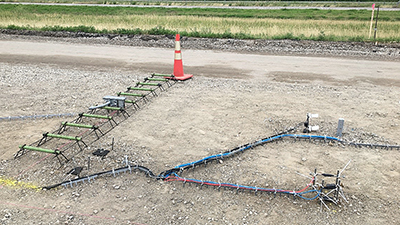
A portion of sensors installed and ready for concrete paving at MnROAD site. Photo by Lauren Dao
|
In early June, instrumentation and geotechnical preparation got underway, including laying base and subbase layers, grading, and adding geotextiles before the asphalt paving could begin on the perpetual pavement studies. MnROAD staff, along with District 3 support, installed conduit, vaults and tower bases in preparation for the sensor instrumentation. Certain base layers and all the asphalt and concrete sections were prepared, with a total of nearly 900 sensors. These sensors will record temperature, moisture, strain on the pavement under traffic and other information to aid researchers in understanding the performance of the test cells.
“With the instrumentation required, along with the new paving materials, we really appreciated the help from industry partners and academia,” said Ben Worel, MnROAD operations engineer. “The District 3 support staff from the Monticello Truck Station were indispensable throughout this construction, primarily in assisting with the instrumentation. Others from District 3, the MnROAD staff, and across MnDOT did a lot of work to help make sure this project was done on schedule.”
A total of 20 cells of asphalt pavements and 19 cells of concrete pavements have been paved so far this summer, and will work continue through early September. These cells represent 11 different efforts funded by MnDOT and the NRRA, covering topics including:
- Three projects involving the use of alternative cementitious materials
- Concrete full depth repairs
- Perpetual pavement
- Reclamation and recycling techniques to achieve perpetual pavements characteristics
- Reflective cracking challenge and NCAT additive group study
- Weigh-in-motion technologies
- Early loading whitetopping
- Void Reducing Asphalt Membrane and joint bond effectiveness
- Intelligent compaction performance evaluation of wicking geotextiles for improving drainage and stiffness of road foundation
To complete this work, partners representing more than 20 universities and other organizations have spent time with MnDOT staff and contractors to assist with the construction, perform testing on materials, oversee the placement of donated products for testing or just see the projects in progress. This list included but was not limited to: PCi, C.S. McCrossan, District 3 staff, American Engineering Testing, Braun Intertec, Agg Industries, Michigan State University, University of Texas El Paso, University of North Dakota, SolMax, Evercore, INGIOS, ANTIGO, Northwestern Surveying & Engineering, Caterpillar Global Paving, University of New Hampshire, J.R. Larson, District 7A staff, The Transtec Group, North Dakota DOT, Iowa DOT and Park Engineering.
In addition to those working directly with the projects, two additional mobile laboratories spent time on site. The NCAT team brought their mobile testing lab to support the additive group HMA testing. Federal Highways Administration brought their mobile concrete lab to complete some advanced concrete mix testing.
The National Road Research Alliance hosted tours of the site to attendees of the Minnesota Transportation Conference & Expo in May. The NRRA also held a special event on concrete sustainability at the end of July, which brought over 100 people from around the country and Canada to discuss ways to improve the environmental and climate impact of concrete use.
In the last month, the work at MnROAD has been featured in three different media outlets: Minnesota Public Radio’s “Climate Cast” show, WCCO’s “Next Weather” and “Extra” on KARE-11. |
 |
|

|
 |
TABLE of CONTENTS
 |
MnDOT spends $148 million to clear roads during 2021-22 winter season |
By Anne Meyer
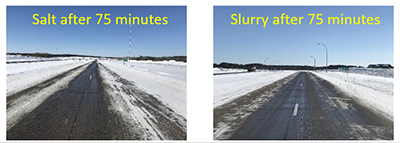
Photo from Camp Ripley showing the results of a materials test comparing rock salt and slurry. The slurry side reached bare lane targets sooner and used less material overall. Photos courtesy of Jed Falgren |
While snow and ice crews prepare for the winter season ahead, MnDOT is getting a closer look at the 2021-22 season thanks to the release of the annual winter “At-a-Glance” report.
The agency spent $148 million during 2021-22 on snow and ice operations statewide, which includes labor, materials and other expenses. This is a nearly 30% increase from the previous winter season, although recent inflation did impact some costs. The report breaks down costs and use of materials in each district.
This past winter season was one of the most severe since 2018, according to the annual winter severity index. Above-average snowfalls and intense blizzard winds kept crews in northern and western Minnesota working long hours. Typically, that area may see two to three blizzards during the winter, but this season there were 10. District 2 and District 4 describe the hard work it took to keep roads open, even on days when the snow wasn’t falling.
“Our crews did a phenomenal job. When we needed drivers to work longer and harder, they gave us 110%,” said Don Nosbisch, District 2 operations superintendent. “The same is true for our shops, who kept equipment going; our office and public affairs staff, who answered questions and gave updates to travelers; and our upper management who gave us continuous support throughout the busy season.”
The report also includes information about the expanded use of liquid materials in winter maintenance operations statewide. Crews are seeing impressive results whenever they put more liquids into the equation, and there’s room to expand use in the coming years. The report describes a test performed at Camp Ripley after a snowstorm in February 2022: on one side of the track, crews used solid rock salt; on the other, they used a slurry mixture combining solid rock salt with brine.
You can see the full 2018-19 Winter At-a-Glance report and reports from previous years on the maintenance website.
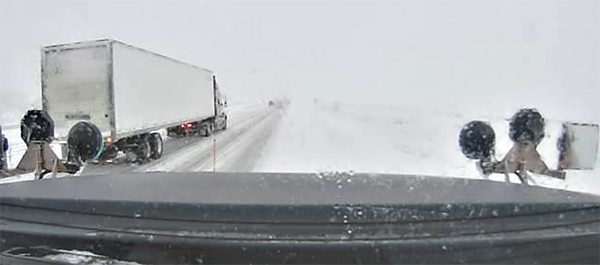
Blizzard conditions from a snowplow camera near Fargo on Feb. 2, 2022. Photo courtesy of District 2
|
|
 |
|

|
 |
TABLE of CONTENTS
 |
New MnDOT Bikeways online map offers detailed route information |
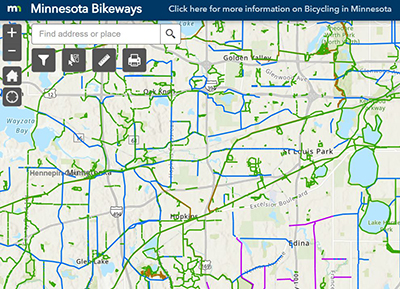
MnDOT’s new web-based Minnesota Bikeways map can help people better picture where they want to pedal. The map shows nearly all known bikeways in Minnesota and users can click on individual segments to see more information. |
By Joseph Palmersheim
MnDOT’s new web-based Minnesota Bikeways map can help people better picture where they want to pedal.
The map shows nearly all known bikeways in Minnesota and users can click on individual segments to see more information. They can use embedded tools to filter routes by surface type and other attributes, create queries and measure or print their route. The layer list in the upper right corner of the map includes additional information that can be toggled on and off. This online version complements the printed map that MnDOT publishes every two years.
The project isn’t an app in the traditional sense. Instead of downloading something to a phone, a user can access the Bikeways map through their mobile browser.
Google and Apple Maps might show what road to take and how long it may take to get there. But they don’t provide other helpful bicycling information like annual average daily traffic numbers, how wide the path or road shoulder is, or type of riding surface.
“This kind of information can help a person determine how comfortable they may feel bicycling on a specific route,” said Michael Petesch, pedestrian and bicyclist data coordinator. “Compared to a printed map, this allows people to zoom in and see neighborhood-level details. They can better tell what is connecting to what. It’s a finer grain of information.”
Part of the project’s initial work in 2019 included developing a consistent standard for what information to include on the map. While information from a variety of partners was available, some data was more comprehensive than others. MnDOT staff partnered with the Minnesota Geospatial Advisory Council to develop a new set of Bikeways Data Standards in 2021. Now, Petesch said, these cleaner data sets allow information to be displayed more consistently, which makes updating it easier and enhances user experience and confidence in the data.
The Minnesota Department of Natural Resources and local partners (cities, counties and regional governments) currently provide most of the route and attribute information. However, anyone can submit bikeway edits using the online Minnesota Bikeways Crowdsourcing tool.
Phase Two plans for the project include developing Avenza maps for bikeways in each Minnesota county. Users will be able to download these maps on their iOS and Android mobile devices and navigate withoutthe Internet or network connections.
Instead of only printing a new map every two years, Petesch said, this online map will help MnDOT provide better and more frequent updates a few times a year.
“Our goal is to provide helpful information to people so they can plan detailed routes throughout Minnesota or within their neighborhood,” Petesch said. “If they’re bicycling to grab a sandwich or go to school or cross the entire state, we hope people use this map to make awesome bicycling memories.” |
 |
|

|
 |
TABLE of CONTENTS
 |
Staffing updates |

Brian Kary. |
Brian Kary begins new director role
Brian Kary has accepted the Transportation Systems Management and Operations director position, effective Aug. 31. He will lead the agency’s efforts to implement strategies to improve the safety, operations, efficiency and performance of MnDOT’s multimodal system.
Kary’s prior work with the department has included freeway operations, traffic analysis, and incident management. Most recently, he was the director of traffic operations, overseeing the daily operations and program delivery sections of the Regional Transportation Management Center, which includes the E-ZPass system, the FIRST program and ramp metering.
Laura Roads steps into new role in commercial vehicle operations

Laura Roads |
Laura Roads has begun a new role as the assistant director for the Office of Freight and Commercial Vehicle Operations, overseeing commercial vehicle operations. Previously, she worked as a staff attorney in FCVO for eight years, advising on the laws governing commercial motor vehicles and other for-hire transportation services, working with industry stakeholders and partners at other agencies and assisting the Governor’s Office with transportation-related emergency executive orders.
Roads has been actively involved during legislative sessions to help represent the interests and initiatives of the Commercial Vehicle Operations section, and worked with the Office of Government Affairs in the legislative mobility role for the 2020 and 2021 sessions.
In fall 2021, she moved to the Office of Chief Counsel, where she took on some new assignments helping the CAV-X Office and assisting the agency with audits involving the Office of Legislative Auditor. |
 |
|

|
 |
TABLE of CONTENTS
 |
On the job: From student worker to full-time employee, Erika Mejia works hard in Human Resources |
By Kiran Sjoberg

Erika Mejia currently works in human resources for MnDOT. Submitted photo |
After joining MnDOT as a student worker and graduating from the Seeds program, Erika Mejia entered the agency’s MnROW program, where she is now a Human Resource Specialist One.
Where are you from and where did you go to school?
I am from Mahtomedi, Minnesota. I graduated from Metropolitan State University where I studied organizational communication and human resources management.
Why did you decide to accept a job at MnDOT?
MnDOT has great employee morale and the benefits are stellar. I enjoyed working for the agency during my time as a student worker, so I decided to continue with MnDOT after I graduated.
What does a typical workday look like for you?
My focus in this current position includes recruitment and staffing activities. Each day consists of different activities. During recruitment season, I try to attend as many career and job fairs as possible. I have attended both in-person and virtual hiring events. I also take care of posting MnDOT jobs on online recruitment websites, such as Indeed and MinnesotaJobs, while also sending the daily jobs to the Department of Management and Budget. Another daily task of mine is to monitor the Employee Referral Program. I will also soon be working on job audits and classifications, which I am very excited about.
What was your biggest takeaway from being a student worker in the Seeds program?
My biggest takeaway from the Seeds program was the experience and professional development. The program is wonderful, and I would recommend it to any family, friends, or individuals who may be interested that fit the criteria of the program.
What is the MnROW program and what do you do for it?
The MnROW program was established in 2017 and is a program for past Seeds students to further their development in individual’s desired fields of work. The goal is to retain recent Seeds program graduates by providing full-time, on-the-job development positions, making employees highly qualified to compete for permanent jobs within MnDOT. I am currently in the MnROW program working as an Human Resources Specialist One in Central Office.
What do you see yourself doing in five years?
In five years, I see myself continuing to advance my skills in knowledge in human resource management.
Do you or a co-worker have an interesting job to share with readers? Send us your ideas, and we’ll contact you for more information.
Recent employee profiles:
|
 |
|

|
 |
TABLE of CONTENTS
 |
State Fair booth returns with zipper merge demonstration, Betty Whiteout |
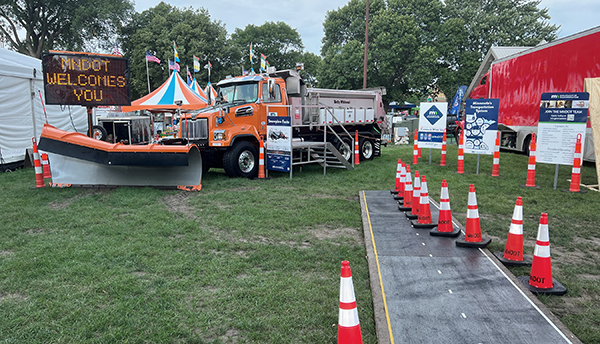
If you plan to visit the Minnesota State Fair, stop by MnDOT’s space on Cosgrove St. across from the Education Building. You can sit behind the wheel of the “Betty Whiteout” snowplow, see road samples, practice a zipper merge, pick up a free state highway map and more. Thank you to all the volunteers who help us staff our space each year. Photo by Anne Meyer |
|
 |
|
| |
|



